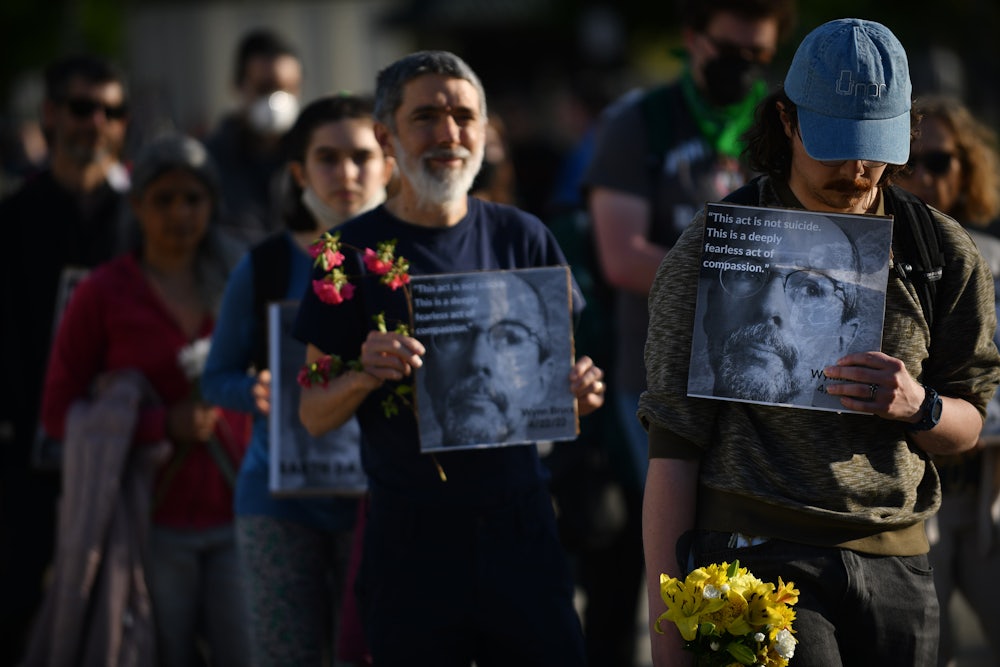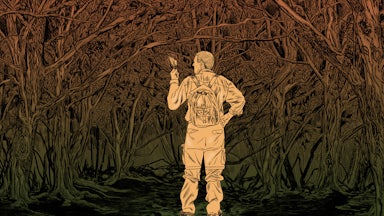Is self-immolation protest or pathology? This is the question weighing on everyone who knew Wynn Bruce, the Colorado man who set himself on fire outside the U.S. Supreme Court on Earth Day, or who has heard his story in the weeks since.
Bruce, a photographer, environmentalist, and practicing Buddhist, left no note. But his father and friends in the Buddhist community of Boulder have interpreted his death as a climate protest—an interpretation supported by several of Bruce’s social media posts. However, this wasn’t Bruce’s first attempt at self-immolation, his father told The Washington Post. Bruce had tried something similar in 2017, in front of the World Trade Center in New York, but bystanders put out the flames before anyone got hurt. His father subsequently “set him up with psychological support services,” the paper reported, but Bruce would not discuss his feelings with his family.
All of this presents a serious conundrum for how to discuss Bruce’s death and others like it. The stories the living tell themselves about the deceased can conceal as much as they reveal; in the worst cases, they can even cause further harm—by stigmatizing those who already grapple with suicidal thoughts and behaviors or by irresponsibly valorizing suicide and inspiring new acts of self-harm. That’s why guidelines for journalists covering suicide specifically discourage speculation about cause. And that’s probably why Bruce’s death—despite the Washington Post profile—has received startlingly little coverage or op-ed discussion in the weeks since it happened. Yet silence feels like an unsatisfactory alternative. In seeking to understand deaths by suicide, we are trying to understand ourselves and the world we live in.
In Western cultures, suicide is typically understood as the consequence of mental illness—or, at the very least, immense anguish. Psychiatrists understand suicide as the consequence of what’s called cognitive constriction. Some people “fail to see alternatives to what they’re doing,” says Brendan Kelly, a professor of psychiatry at Trinity College Dublin and the author of the recent history In Search of Madness. “Many people who end their lives say, ‘I had no other choice.’” They are, of course, mistaken: talking with friends, family, and community and seeking out religious, medical, or social services can help. When such support isn’t pursued or provided, it only compounds the sense of tragedy.
In other countries, cultures, and historical periods, suicide is not always automatically medicalized, pathologized, or individualized. But almost nowhere in the world is suicide actively encouraged—including in Buddhist communities, contrary to many Euro-American interpretations of Eastern spiritualities. When it comes to self-immolation, in particular, “these are such powerful things visually and imaginatively that they command attention and suggest a prevalence that is not there,” Kelly, who has researched and written extensively about the intersections between Buddhism and psychiatry, tells me. “These are very, very unusual acts, and they are by no means universally agreed upon.” They have also changed over the past few decades in important ways.
Self-immolation, also known as self-cremation, can be traced back for almost two millennia, from sati (in which some South Asian widows sat on their husband’s funeral pyre) to the politically and spiritually motivated self-immolation among Chinese Buddhist nuns and monks starting around 400 A.D. But for most of this time, self-immolation was very difficult, according to a recent history by French psychiatrist Jeremie Sinzelle. It required collecting materials and methodically constructing a pyre, which served as what suicidologists might today call a natural form of “means restriction” and presented multiple opportunities for others to intervene.
That changed with the widespread adoption of flammable liquids like gasoline, which Sinzelle reports sparking fears of a self-immolation trend long before any such demonstrations were actually undertaken. In 1963, the death of South Vietnamese monk Thích Quảng Đức made good on these fears. It also catapulted self-immolation into the global imagination, Tsering Shakya, a professor in the Institute of Asian Research at the University of British Columbia, tells me.
Quảng Đức is widely understood to have self-immolated in protest of anti-Buddhist discrimination under a Catholic government. “In Buddhism the first important precept is not killing—not killing oneself and not killing others,” another monk, Thích Thiên-Ân, who was incarcerated in this period for his religious beliefs, has said. “But in such an emergency,” he continued, referring to the repressive final period of the U.S.-supported Ngo Dinh Diem presidency in South Vietnam, “there was no other way to help. They were using their bodies like a lamp for help.”
The monk’s death did indeed spark change, according to Thiên-Ân. That was in part because the moment was captured by the American journalist Malcolm Browne. “No news picture in history has generated so much emotion around the world as that one,” then-President John F. Kennedy reportedly said. It drew global scrutiny to prison conditions and led to the release of Buddhist prisoners. (Diem’s government later reverted to violent attacks on Buddhist demonstrators, before being ultimately overthrown in a military coup.)
Quảng Đức’s death led many people—from far outside his culture and context—to conclude that self-immolation could be a successful means of protest anywhere. In March 1965, Alice Herz, an 82-year-old activist, set herself on fire on a street in Detroit and died of her burns 10 days later. In a letter, she asked her fellow Americans to “awake and take action” against the Vietnam War, calling her suicide an effort “to make myself heard.” A few months later, in November 1965, Norman Morrison, a 31-year-old Quaker, also self-immolated in protest of the war—outside the Pentagon under Secretary of Defense Robert McNamara’s Pentagon office.
But these deaths did not have the impact Herz or Morrison might have imagined. Herz’s death received barely 300 words on page three of The New York Times. In his memoirs, McNamara said that Morrison’s death and his wife Anne Morrison’s writings about the aftermath profoundly affected him, yet he continued to push the war in Vietnam forward until his resignation in 1968, and American involvement in the conflict continued until 1975. As Morrison’s daughter Tina put it succinctly: “It didn’t stop the war.”
While secondary to the awfulness of suicide itself, this issue of inefficacy has continued to follow self-described protest suicides. Sometimes, they spark a revolution, as in the Arab Spring, which is believed to have begun with the self-immolation of a Tunisian fruit vendor. Other times, particularly in the West, such a death hardly seems to register. It’s not just a matter of callousness or confusion. When activists self-immolate in the United States these days, coverage is intentionally subdued.
To tell a story about suicide is to take a risk—not with your own life but with the lives of others. Since at least the eighteenth century, people have observed a rise in copycat suicides immediately following mass media depictions of such deaths. The 1744 publication of Goethe’s The Sorrows of Young Werther, a novel that ends in the protagonist’s suicide, sparked a deadly trend among young men in Europe—the so-called “Werther effect.” Epidemiological research has subsequently borne this out: Across time and space, descriptions of suicide can lead to contagion.
That’s why initiatives like Reporting on Suicide have worked to provide journalists around the world with guidelines designed to protect vulnerable members of their audience. The recommendations suggest journalists avoid:
● “describing or depicting the method and location of the suicide”;
● “sharing the content of a suicide note”;
● “speculating on the reason for the suicide” (however, the initiative does encourage journalists to “describe warning signs and risk factors, including mental illness”);
● “presenting suicide as a common or acceptable response to hardship” or “glamorizing or romanticizing” suicide; or
● “describing intimate details about the person who died.”
As a journalist who writes about both the climate crisis and mental health, I agree with all of these recommendations. They are common sense and evidence-based. Yet you might have noticed that I’ve already broken some of these rules in this piece. Self-immolation is both a tradition and a “method” being described. People who die by suicide occasionally promote a message directly to media or make clear they want their statements shared; in some cases, outlets oblige. And reasonable people can disagree about the finer points on many of these topics, from the nature of suicide to the role of protest in self-immolation. What no one wants is more of these painful deaths.
So when these deaths do occasionally occur, they can feel impossible to address. In 2018, for example, a 60-year-old LGBTQ rights lawyer and community composter named David Buckel self-immolated in Brooklyn’s Prospect Park. “My early death by fossil fuel reflects what we are doing to ourselves,” he wrote in a note circulated to loved ones and journalists minutes prior to his death. Buckel’s death did draw some attention. It was written up in a short news item for The New York Times and later garnered a deeper posthumous profile in The Guardian.
But even with this relatively muted response, coverage of Buckel’s death drew criticism. “People do not die by suicide out of concerns over fossil fuels, or any other public policy issue,” Ann Haas of the American Foundation for Suicide Prevention and Andrew Lane of the National Action Alliance for Suicide Prevention wrote in a letter to The New York Times in response to the paper’s initial coverage.
Haas and Lane’s point—that everyone endures financial, emotional, and now climatic hardships but not everyone dies by suicide—is unimpeachably true. People do not die by suicide out of concerns over fossil fuels alone. But I still wonder whether David Buckel might have. While those who die by suicide are treated, understandably, as unreliable narrators of their own mind, it seems just as unreliable a narration to retell the stories of Herz, Morrison, Buckel, and others stripped of their intellectual or political commitments.
Even so, the other extreme—something akin to an embrace of self-immolation as protest—is equally discomfiting, as witnessed in the aftermath of Wynn Bruce’s recent death. “This act is not suicide. This is a deeply fearless act of compassion to bring attention to the climate crisis,” Kritee Kanko, a climate scientist and Zen Buddhist priest in Boulder, tweeted. Kanko, who considered Bruce a friend, added, “#wynnbruce I am so moved.”
While some spectators agreed with Kanko’s message, to others her statement read like an (unintentional) promotion of suicide, one that might harm already vulnerable young adults and others worried about the climate crisis. Ultimately, the Rocky Mountain Ecodharma Retreat Center tweeted a more comprehensive statement denouncing suicide and affirming they did not know of Bruce’s plans and would have stopped him given the opportunity. “We hope we can hear Wynn’s message,” the Ecodharma statement concluded, “without condoning his method.”
That remains a good summary of the challenge: to interrogate suffering without furthering it. To discuss but not sanction. To listen, without compromising on our shared belief in the value of life. When it comes to self-immolation, such subtlety can feel impossible. But this balancing act is more important than ever, as climate change stacks the deck with despair. “I don’t think we can treat his death like it was a valiant, valid decision,” one of Buckel’s colleagues told The Guardian in 2019. But “if it is going to have a public component—then I think that public component should reflect the issue he connected his death to.”
The National Suicide Prevention Lifeline is a hotline for individuals in crisis or for those looking to help someone else. To speak with a certified listener, call 1-800-273-8255.










